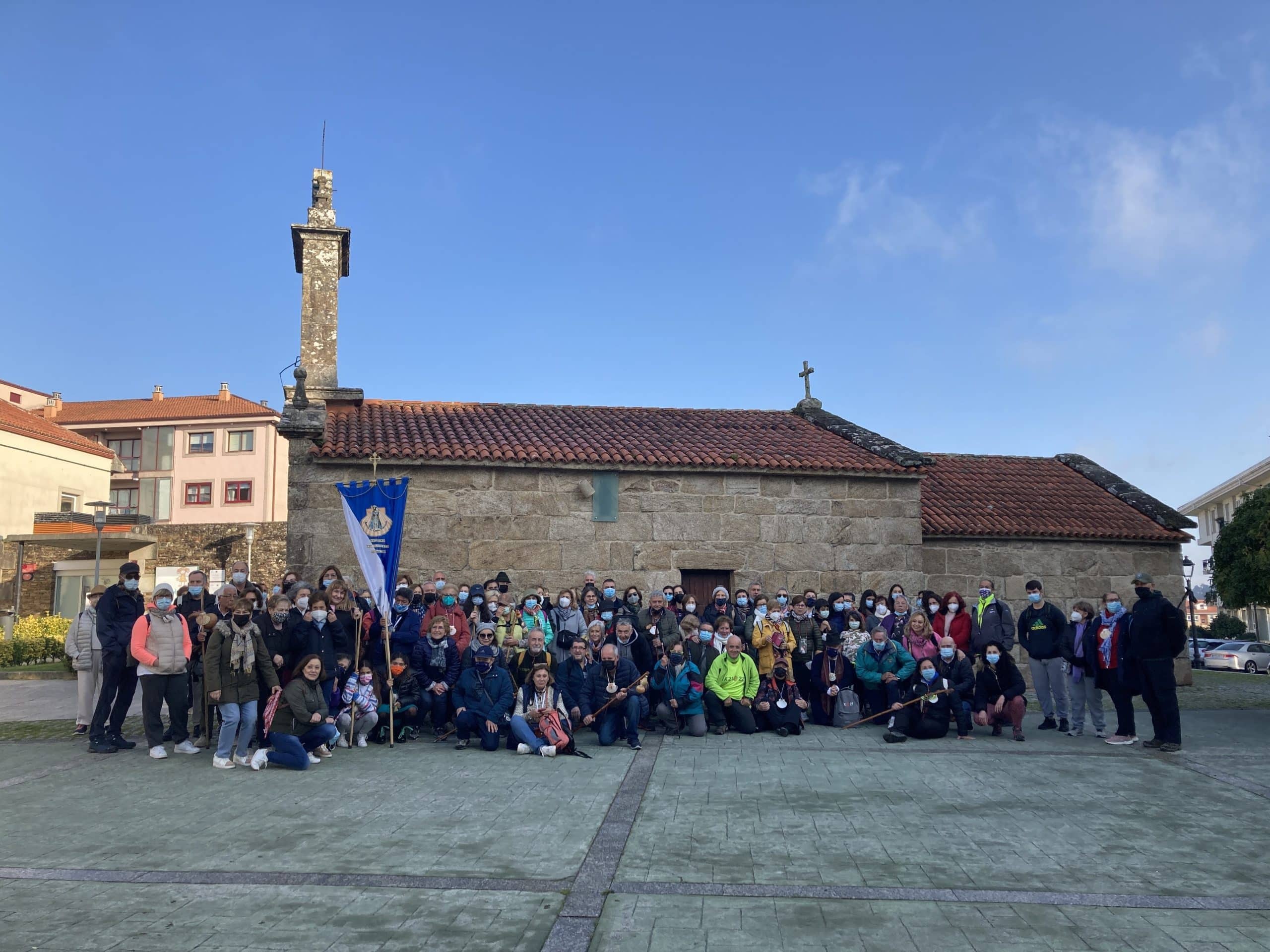We finally make it to Santiago! After several Sundays of walking the Camino Portugués, we finish our pilgrimage with a very short stage: O Milladoiro-Santiago de Compostela.
If you’ve been following the previous posts you’ll already know this, but in case you don’t:
I walked part of the Camino Portugués (central route) between October and November 2021, with a group organised by the Asociación de Amigos del Camino Portugués. Every Sunday, a bus would pick us up in Pontevedra and take us to our starting point for the day. From there, we would walk a stage of this route; and then the autobús (bus) would take us back home.
This particular Sunday we walked the final 7-8km into Santiago, from O Milladoiro. A few more people than usual joined us for this last stage, so we had 2 buses instead of one.
We were again very lucky with the weather: another bright, sunny day. In fact, the weather was unusually good for most of noviembre (November). Since we didn’t have to walk that much, we left Pontevedra a bit later than usual.
We gathered outside Capilla de la Magdalena for the prayer and group pictures.

Group picture before we started walking, as usual. Outside A Magdalena chapel.
O Milladoiro
There is not much to see in O Milladoiro, apart from this chapel. A few years ago, O Milladoiro was just a small aldea (village). But high housing prices in Santiago pushed many (young people, mainly) out, looking for more affordable options. O Milladoiro is quite close and well connected through the N-550 road, so it has experienced tremendous growth.
There are 2 theories about the origins of the name of this town.
- According to one theory, it comes from Latin humilliatorium, which makes reference to the fact that pilgrims used to kneel down here, when they could finally see Santiago, and the cathedral, in the distance.
- The second theory says it comes from the Galician word miradoiro (mirador in Spanish, view point in English) because from this high point you can see Santiago and the cathedral for the first time.
Either way, the name of the town is linked to Santiago de Compostela and its cathedral.
O Milladoiro-Santiago de Compostela
I was familiar with the routine by now. But there was something new this time: they brought the association’s banner that had been created for the 1993 Holy Year.
This banner was carried by different people throughout the stage.
The short stage and the banner meant that the group didn’t spread out so much this time. We also walked at a slower pace than usual, because the idea was for the whole group to stay behind the banner. And the constant change of standard bearer meant lots of stopping and picture taking.
Apart from that, the stage was quite uneventful: walking through small villages and some forest areas, with no important climbs or descents and Santiago getting closer and closer. We soon reached the Alameda, where we stopped to regroup and take some pictures before we marched, together, to the cathedral.
It was my first time back in Santiago in a very long time. First time inside the cathedral since they finished renovating it. I would have loved to see the Pórtico de la Gloria or do the rooftop tour, but they’re not open on Sunday evenings. What a great excuse to go back to Santiago!
You can see some pictures of this O Milladoiro-Santiago stage in the following video:
The Pilgrim’s office
I didn’t get a credencial or collect stamps for this Camino. I started walking in Porriño, which is right at the 100km mark and qualifies for a Compostela. But I knew I was going to skip a couple of stages that I had already walked before. So, I didn’t bother.
When I walked the Camino Inglés in 2019, the waiting time at the Oficina del Peregrino (Pilgrim’s office) was at least 2 hours… and I didn’t feel like waiting in line for so long. So, I didn’t collect my Compostela back then. But it occurred to me that being November, the waiting time would be short. And so I took my old credencial with me, to see if I could get a Compostela for my 2019 Camino.
After a few pictures at the Praza do Obradoiro*, some of us headed to the Pilgrim’s office. The old ‘join the queue when you get there’ system is gone, partly due to covid, partly to avoid long queuing times.
So now there is a QR code outside. You scan it and it opens up a page where you can register your details. After you complete this step, you receive a message with a code. You show this to the person at the entrance and they give you a piece of paper with your number.
There were not many people around that day, so I was able to enter the building straight away.
Most of the people in my group were older (in their 70’s, on average) and not very tech-savvy. They were struggling with this new system and the security guard standing outside wasn’t very helpful, to be honest. There was a man, for instance, who didn’t have a smartphone. There was someone trying to help him, I hope he was able to get his Compostela. I managed to help a lady who did have a smartphone, but couldn’t scan the QR code to start the registration process.
In short, lots of frustration for these people who were looking forward to receiving their Compostela, and probably some were not able to. Not having to wait in line for hours during busy times is good. But making it almost impossible for those who are not so tech-savvy is not so good.
Anyway, I managed to get my Compostela. It has 2 fechas (dates) on it: I day I collected it and the day I finished my Camino Inglés (they added this by hand, under the other date).
Hostal dos Reis Católicos
There were a couple more activities organised for the day: a guided tour of the Parador, lunch (at the Parador too) and misa del peregrino (pilgrim’s mass) at 7.30pm. I couldn’t stay that late, due to family obligations. But I did join the visit to the Parador before I returned home.
Paradores are part of a chain of luxury hotels, managed by a state-run company. They are usually located in historic buildings such as castles or convents.
In Santiago, we have the Hostal dos Reis Católicos**, right beside the cathedral. It was built at the beginning of the 16th century by Isabel de Castilla and Fernando de Aragón, los Reyes Católicos (Catholic Monarchs) as a hospital that cared for the pilgrims arriving in Santiago de Compostela. It’s built around 4 patios, all of them different. Construction began in 1501 and lasted 10 years. The Hostal dos Reis Católicos is considered the oldest hotel in Spain.
You can enjoy a few pictures from my visit:
Today’s Spanish words
* Praza is the Galician word for plaza (square). You can listen to the pronunciation of plaza in Santiago de Compostela. You will also find misa del peregrino there.
** Reis is the Galician word for reyes (kings or monarchs).
For the pronunciation of autobús, check En autobús.
For the pronunciation of Alameda, check Pontevedra.
For the pronunciation of credencial, check ¿Cómo vas a hacer el Camino?
For the pronunciation of noviembre, check Samaín.
Capilla de la Magdalena
Aldea
Miradoiro
Mirador
Oficina del peregrino
Praza do Obradoiro
Fecha
Reyes Católicos
Hostal dos Reis Católicos
Have you read about the previous stages?
Make sure you don’t miss any posts by subscribing for free here. That way, when a new post is out, you will get it in your inbox. And… you get access to exclusive content too.



